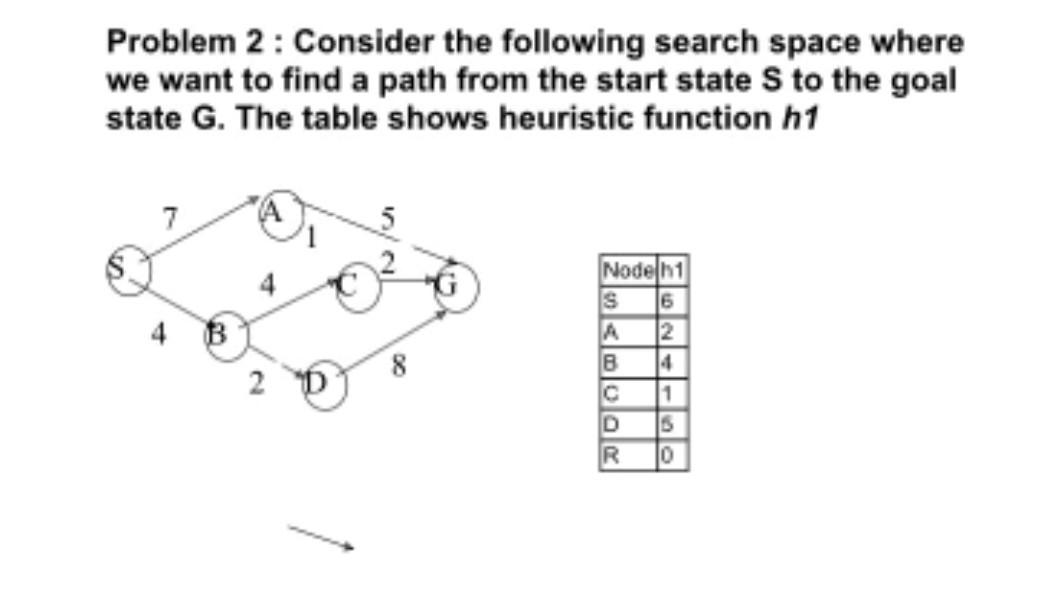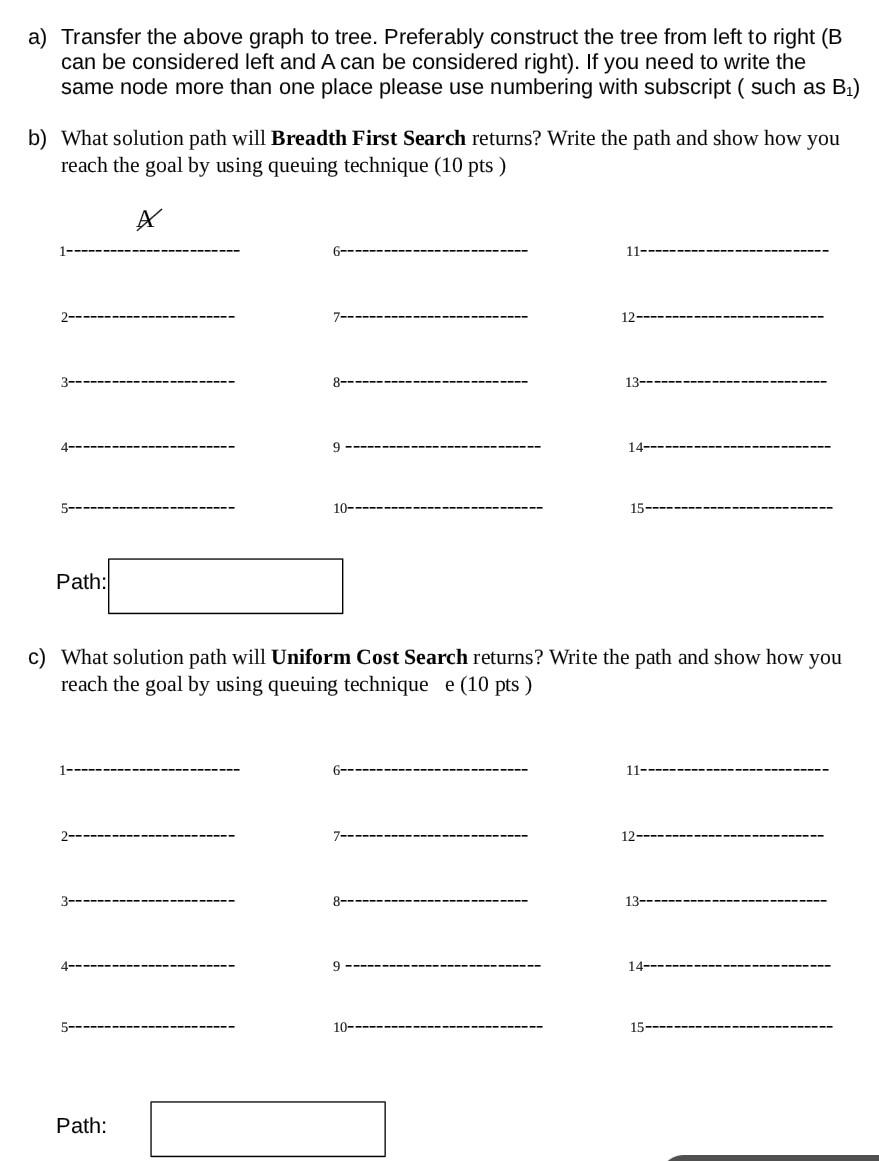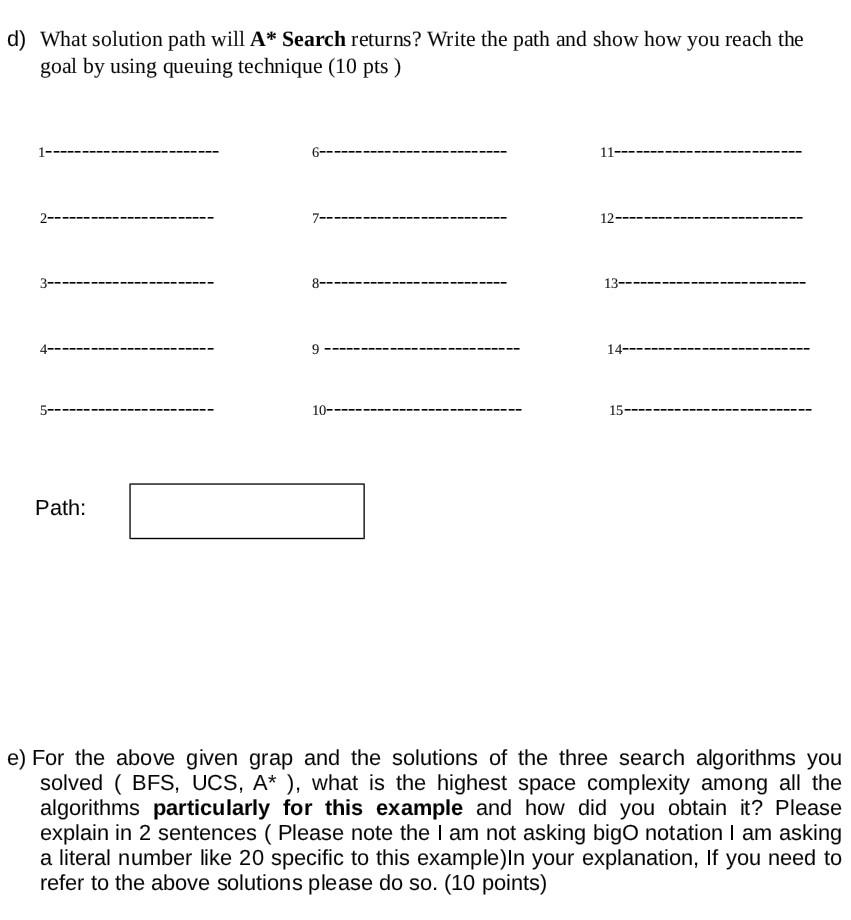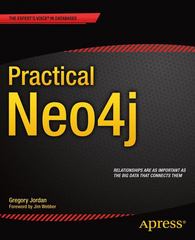Answered step by step
Verified Expert Solution
Question
1 Approved Answer
Screen 2 screen 3 screen 4 artificial intelligence questions if you can help me in a few hours appriciated. Problem 2: Consider the following search

Screen 2

screen 3

screen 4

artificial intelligence questions if you can help me in a few hours appriciated.
Problem 2: Consider the following search space where we want to find a path from the start state S to the goal state G. The table shows heuristic function h1 2 8 Node 1 S 6 A 12 8 14 11 D IS R 0 2 8 1 : Consider the following search problem as represented in the below tree. The start state is given as A and the goal state is represented as G (all of the nodes represented as G1, G2, G3, G4 are actually the same goal G but they are numbered to ease your work in solution) In the below tree, number on the edges which are black represents the actual cost between the nodes and the red values on the nodes represent the heuristic value. Please answer the following questions. Some of the rules you should follow in your solutions as follow. . Do not use colors in your solution. In order to write numbers next to G do not use G1 but either use subscript and write G1. Any cost information written like B2 will not be accepted you should use superscript and it should be written B2 In the questions you should use the queueing techniques as it is done in the lectures even it is possible to solve it in another way, the solutions with different methods won't be accepted. While using the letters in the queue use font-14 (Arial) ex: A For queuing techniques please use the reserved places for you. To show the expanded nodes please use the word (insert-shapes-line) so that it can be easily detected as an example A Follow the line numbers in an order when your write your queue which is top to down. Do not change the font or the format of the below reserved spaces for the questions If you need to draw, please use (insert-shapes) In the queue if you have a node with the same cost of the new expanded one, add the new expanded one after the one available in the queue. . a) Transfer the above graph to tree. Preferably construct the tree from left to right (B can be considered left and A can be considered right). If you need to write the same node more than one place please use numbering with subscript ( such as B2) b) What solution path will Breadth First Search returns? Write the path and show how you reach the goal by using queuing technique (10 pts) 11- 13-- 9 14 15- Path: c) What solution path will Uniform Cost Search returns? Write the path and show how you reach the goal by using queuing technique e (10 pts ) 6-- 11 13--- 9 1 5-- 10--- 15- Path: d) What solution path will A* Search returns? Write the path and show how you reach the goal by using queuing technique (10 pts) 1- 6--- 11----- 2-------- 7------ 12 3-- 8-- 13----- 4-- 9 14--- 5-- 10-- 15---- Path: e) For the above given grap and the solutions of the three search algorithms you solved ( BFS, UCS, A* ), what is the highest space complexity among all the algorithms particularly for this example and how did you obtain it? Please explain in 2 sentences (Please note the I am not asking bigo notation I am asking a literal number like 20 specific to this example)In your explanation, If you need to refer to the above solutions please do so. (10 points) Problem 2: Consider the following search space where we want to find a path from the start state S to the goal state G. The table shows heuristic function h1 2 8 Node 1 S 6 A 12 8 14 11 D IS R 0 2 8 1 : Consider the following search problem as represented in the below tree. The start state is given as A and the goal state is represented as G (all of the nodes represented as G1, G2, G3, G4 are actually the same goal G but they are numbered to ease your work in solution) In the below tree, number on the edges which are black represents the actual cost between the nodes and the red values on the nodes represent the heuristic value. Please answer the following questions. Some of the rules you should follow in your solutions as follow. . Do not use colors in your solution. In order to write numbers next to G do not use G1 but either use subscript and write G1. Any cost information written like B2 will not be accepted you should use superscript and it should be written B2 In the questions you should use the queueing techniques as it is done in the lectures even it is possible to solve it in another way, the solutions with different methods won't be accepted. While using the letters in the queue use font-14 (Arial) ex: A For queuing techniques please use the reserved places for you. To show the expanded nodes please use the word (insert-shapes-line) so that it can be easily detected as an example A Follow the line numbers in an order when your write your queue which is top to down. Do not change the font or the format of the below reserved spaces for the questions If you need to draw, please use (insert-shapes) In the queue if you have a node with the same cost of the new expanded one, add the new expanded one after the one available in the queue. . a) Transfer the above graph to tree. Preferably construct the tree from left to right (B can be considered left and A can be considered right). If you need to write the same node more than one place please use numbering with subscript ( such as B2) b) What solution path will Breadth First Search returns? Write the path and show how you reach the goal by using queuing technique (10 pts) 11- 13-- 9 14 15- Path: c) What solution path will Uniform Cost Search returns? Write the path and show how you reach the goal by using queuing technique e (10 pts ) 6-- 11 13--- 9 1 5-- 10--- 15- Path: d) What solution path will A* Search returns? Write the path and show how you reach the goal by using queuing technique (10 pts) 1- 6--- 11----- 2-------- 7------ 12 3-- 8-- 13----- 4-- 9 14--- 5-- 10-- 15---- Path: e) For the above given grap and the solutions of the three search algorithms you solved ( BFS, UCS, A* ), what is the highest space complexity among all the algorithms particularly for this example and how did you obtain it? Please explain in 2 sentences (Please note the I am not asking bigo notation I am asking a literal number like 20 specific to this example)In your explanation, If you need to refer to the above solutions please do so. (10 points)Step by Step Solution
There are 3 Steps involved in it
Step: 1

Get Instant Access to Expert-Tailored Solutions
See step-by-step solutions with expert insights and AI powered tools for academic success
Step: 2

Step: 3

Ace Your Homework with AI
Get the answers you need in no time with our AI-driven, step-by-step assistance
Get Started


